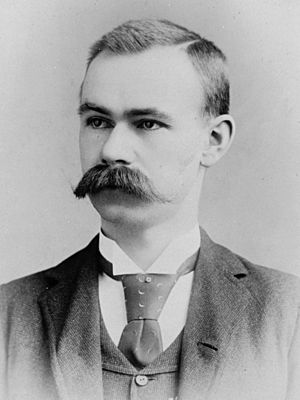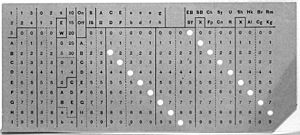Herman Hollerith facts for kids
Quick facts for kids
Herman Hollerith
|
|
|---|---|

Hollerith c. 1888
|
|
| Born | February 29, 1860 Buffalo, New York, U.S.
|
| Died | November 17, 1929 (aged 69) Washington, D.C., U.S.
|
| Resting place | Oak Hill Cemetery |
| Education |
|
| Occupation |
|
| Known for |
|
| Spouse(s) | Lucia Beverly (Talcott) Hollerith |
| Children | 6 |
| Awards |
|
Herman Hollerith (born February 29, 1860 – died November 17, 1929) was an amazing American inventor and businessman. He created a special machine that could read information from punched cards. This machine helped to quickly count and organize large amounts of data.
His invention of the punched card machine, patented in 1884, was a huge step forward. It started the age of machines that could process information automatically. His ideas were used for almost 100 years! Hollerith also started a company that later became IBM, one of the biggest and most successful companies ever. Many people see him as a key figure in the history of data processing.
Contents
Herman Hollerith's Early Life and Education
Herman Hollerith was born in Buffalo, New York, in 1860. His parents were German immigrants. He went to the City College of New York when he was just 15 years old.
In 1879, at age 19, he earned a degree in mining engineering from the Columbia School of Mines. Later, in 1890, he earned his PhD. This higher degree was given to him because of the amazing tabulating system he developed. In 1882, Hollerith taught mechanical engineering at the Massachusetts Institute of Technology. There, he started experimenting with punched cards. He later moved to Washington, D.C., where he lived and worked.
How Hollerith Revolutionized Data Processing
Hollerith developed a new way to record and count information. He got the idea from John Shaw Billings. Hollerith realized that you could record data by making holes in specific spots on a card. For example, a hole in one spot could mean "married," and no hole could mean "single."
This simple idea allowed machines to read and count information very quickly. Data arranged in rows and columns on a card could be counted or sorted using electricity and mechanics. Hollerith wrote about this system in his doctoral paper in 1889. His invention was granted a U.S. patent on January 8, 1889.
Hollerith's Inventions and Business Ventures

After teaching, Hollerith started working for the United States Census Bureau. He filed his first patent application for an "Art of Compiling Statistics" in 1884. The patent was officially given to him in 1889.
Hollerith first ran his business under his own name. It was called The Hollerith Electric Tabulating System. He specialized in machines that processed data using punched cards. He rented his tabulators and other machines to the Census Office. They used his machines for the 1890 census.
His machines made a huge difference. The 1880 census took eight years to process. But with Hollerith's electromechanical tabulators, the 1890 census was finished in just six years!
In 1896, Hollerith started a new company called the Tabulating Machine Company. Many census bureaus around the world rented his equipment. Large insurance companies also used his machines. Hollerith's machines helped with censuses in many countries, including England, Italy, Germany, and Canada. They were also used again for the 1900 U.S. census.
He also invented the first automatic way to feed cards into a machine. He also created the first keypunch, which was a machine to make the holes in the cards. His early 1890 Tabulator was designed for the 1890 Census cards. Later, he added a plugboard to his 1906 Type I Tabulator. This made it easier to change the machine for different tasks. These inventions were very important for the start of the data processing industry. Hollerith's punched cards were used for almost a century, even for early computers!
In 1911, Hollerith's company joined with three other companies. They formed a new company called the Computing-Tabulating-Recording Company (CTR). In 1924, under the leadership of Thomas J. Watson, CTR changed its name. It became International Business Machines Corporation, or IBM. By 1933, the original Tabulating Machine Company name was gone, as it was fully part of IBM.
Hollerith's Legacy
Herman Hollerith passed away on November 17, 1929. He is buried in Oak Hill Cemetery in Washington, D.C.
The famous Hollerith cards were named after him. His inventions truly changed how we handle information. His work laid the groundwork for modern computers and data processing.
See also
 In Spanish: Herman Hollerith para niños
In Spanish: Herman Hollerith para niños
- Unit record equipment
- History of IBM


